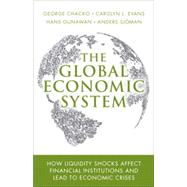
What is included with this book?
George Chacko is Associate Professor of Finance at Santa Clara University’s Leavey School of Business and formerly Associate Professor at Harvard Business School, Managing Director at State Street Bank, and Chief Investment Officer at Auda Alternative Investments. He holds a Ph.D. and M.A. in Business Economics from Harvard University and a B.S. from MIT.
Carolyn L. Evans is Associate Professor of Economics at Santa Clara University. She has worked at the Federal Reserve Bank of New York, the Federal Reserve Board of Governors, and the White House Council of Economic Advisers. She holds a Ph.D. and M.A. in Economics and a B.A. in East Asian Languages and Civilizations, all from Harvard University.
Hans Gunawan is Senior Financial Analyst at Skyline Solar and formerly a manager of financial planning and analysis at JAPFA. He holds an MBA from Santa Clara University and a B.S. from University of California, Berkeley.
Anders Sjöman is Vice President of Communications at Voddler. He was formerly Senior Researcher for Harvard Business School’s Paris-based Europe Research Center. He holds an M.Sc. from the Stockholm School of Economics.
| Motivation for Understanding Liquidity Risk | p. 1 |
| Peso Problem | p. 2 |
| Liquidity Risk-The Peso Problem of Our Time | p. 3 |
| WorldCom | p. 4 |
| Hedge Fund Returns | p. 6 |
| The Structure of This Book | p. 8 |
| Endnotes | p. 9 |
| Liquidity Risk: Concepts | p. 11 |
| Introduction | p. 11 |
| What Is Liquidity? | p. 11 |
| Model of Liquidity Costs | p. 15 |
| Liquidity Risk and Liquidity Shocks | p. 21 |
| Liquidity Risk Premium | p. 25 |
| Why Bear Liquidity Risk? | p. 32 |
| Liquidity-Driven Investing (LqDI) | p. 34 |
| Liquidity Risk Exposure in Bank Balance Sheets | p. 42 |
| Propagation of Liquidity Shocks: Systemic Risk | p. 46 |
| From Liquidity Crisis to Credit Crisis | p. 50 |
| Endnotes | p. 52 |
| The Great Depression | p. 59 |
| The Stages of a Liquidity Shock | p. 59 |
| Recognizing a Liquidity Shock-Interpreting the Data | p. 65 |
| Setting the Stage for the Trigger-the Background for the Great Depression | p. 73 |
| Stage 1: The Trigger | p. 79 |
| Stage 2: Change in Liquidity Demanded Throughout the Economy | p. 82 |
| Stage 3: Changes in Bank Balance Sheets | p. 85 |
| Stage 4: Banks Change Activities to Bolster Balance Sheets | p. 87 |
| Stage 5: Effect on Liquidity and Availability of Credit Throughout the Economy | p. 90 |
| Stage 6: Real Effects of Decline in Liquidity Observed Throughout the Economy | p. 93 |
| Conclusion: The Great Depression, a True Liquidity Shock | p. 98 |
| Endnotes | p. 100 |
| References | p. 103 |
| Japan's Lost Decade | p. 105 |
| The Stages of a Liquidity Shock-Revisited and Expanded | p. 105 |
| Recognizing a Liquidity Shock-Interpreting the Data | p. 110 |
| Setting the Stage for the Trigger-the Background to Japan's Lost Decade | p. 117 |
| Stage 1: The Trigger | p. 124 |
| Stage 2: Change in Liquidity Demanded Throughout the Economy | p. 125 |
| Stage 3: Changes in Bank Balance Sheets | p. 129 |
| Stage 4: Banks Change Activities to Bolster Balance Sheets | p. 141 |
| Stage 5: Effect on Liquidity and Availability of Credit Throughout the Economy | p. 149 |
| Stage 6: Real Effects of Decline in Liquidity Observed Throughout the Economy | p. 155 |
| Conclusion: Japan's Lost Decade, a Liquidity Shock That Dragged On | p. 161 |
| Endnotes | p. 162 |
| References | p. 169 |
| The Great Recession | p. 173 |
| The Stages of a Liquidity Shock-Same Applies Now as with the Great Depression | p. 173 |
| Recognizing a Liquidity Shock-Interpreting the Data | p. 176 |
| Setting the Stage for the Trigger-the Background to the Great Recession | p. 182 |
| Stage 1: The Trigger | p. 196 |
| Stage 2: Change in Liquidity Demanded Throughout the Economy | p. 201 |
| Stage 3: Changes in Bank Balance Sheets | p. 205 |
| Stage 4: Banks Change Activities to Bolster Balance Sheets | p. 212 |
| Stage 5: Effect on Liquidity and Availability of Credit Throughout the Economy | p. 217 |
| Stage 6: Real Effects of Decline in Liquidity Observed Throughout the Economy | p. 224 |
| Conclusion | p. 237 |
| Endnotes | p. 238 |
| References | p. 243 |
| Conclusion | p. 247 |
| A Liquidity Crisis | p. 247 |
| Bank Accounting Changes | p. 249 |
| Bank Nationalization | p. 250 |
| Debt Guarantees | p. 252 |
| Central Bank Lending | p. 253 |
| Monetary Policy | p. 255 |
| Fiscal Spending | p. 256 |
| Preventing Liquidity Crises | p. 258 |
| Endnotes | p. 259 |
| Index | p. 261 |
| Table of Contents provided by Ingram. All Rights Reserved. |
The New copy of this book will include any supplemental materials advertised. Please check the title of the book to determine if it should include any access cards, study guides, lab manuals, CDs, etc.
The Used, Rental and eBook copies of this book are not guaranteed to include any supplemental materials. Typically, only the book itself is included. This is true even if the title states it includes any access cards, study guides, lab manuals, CDs, etc.